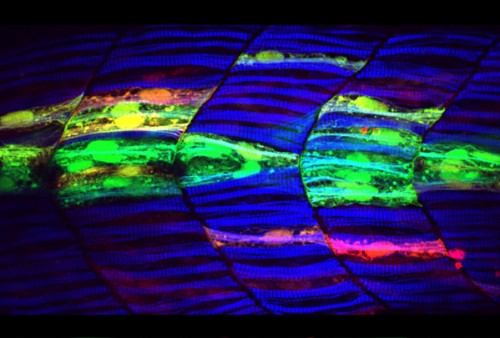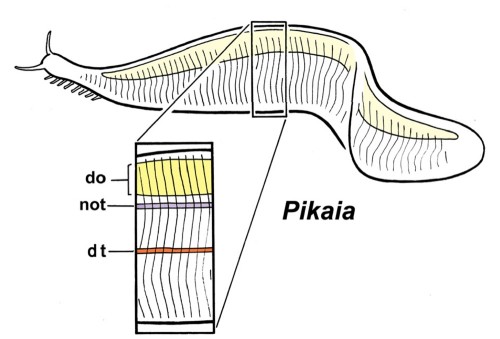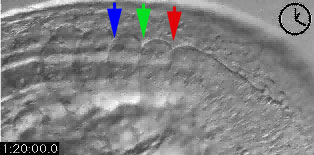If you ever get a chance, spend some time looking at fish muscles in a microscope. Larval zebrafish are perfect; they’re transparent and you can trace all the fibers, so you can see everything. The body musculature of fish is most elegantly organized into repeating blocks of muscle along the length of the animal, each segment having a chevron (“V”) or “W” shape. Here’s a pretty stained photo of a 30 hour old zebrafish to show what I mean; it’s a little weird because this one is from an animal with experimentally messed up gene expression, all that red and green stuff, but look at the lovely blue muscle fibers stretching across the length of each segment.

Lateral view of a 30 hour old zebrafish, embryonic myotome, displaying ectopic eng2a:eGFP (green) fibers in response to Smad7 (marked in red) expressing clones. Slow muscle fibers are marked by monoclonal antibody F59 (blue).
But wait—why the chevron shape? Also, the reason I told you to look in a microscope sometime is that a 2-D image can’t illustrate the lovely intricacy of the muscles; they don’t go straight across, but twist in a partial spiral in 3-dimensions. Trust me, it’s beautiful to see. And it’s also nearly universal in chordates — even Amphioxus has this arrangement. And there’s a good biomechanical reason for this arrangment.
Each of those muscle fibers is attaching to a connective tissue band in the line between each block of muscle, called a myoseptum. The force of contraction of the muscles is going to pull on these connective tissue anchor points, stressing them. By organizing all of the fibers to pull at an angle rather than perpendicularly to the myoseptum, it reduces the amount of force directly applied to the septal connections by as much as 50-60%, depending on the angle, relative to the overall force of contraction applied to generate the bending movements.

The beneficial consequences of having chevron- or V-shaped myomeres, illustrated using amphioxus. (A) The V shape guarantees that the force acting perpendicular to the myoseptum (vector P) is less than the force of contraction (vector F) by an amount that increases with increasing angle (θ) to the vertical. The degree of incline shown is typical for amphioxus larvae, and increases with increasing age. (B) Somite overlap in young adult amphioxus, modified from [11]. The central components of the locomotory system are the notochord (not, shown in violet) and the nerve cord (green). These are bound to the myomeres (pink) by sheaths of basal lamina (blue). The V-shaped myomeres are positioned so that the tip of the caudal-most in any section is adjacent to the notochord, while the extended tails of progressively more anterior myomeres (shown in progressively lighter shades, compare with A) are ranged above and below. Because every point along the notochord has essentially the same complement of septa, this arrangement ensures that the force of contraction experienced by the notochord is distributed evenly along its anteroposterior axis, rather than being borne at specific sites.
An additional benefit is that the angle distributes the force generated by a single segment’s contraction to a longer stretch of the notochord, the central springy rod that forms the main axis of the skeleton.
So why do fish do this? Because with powerful muscle contractions needed for fast swimming comes the potential for tearing connective tissue and buckling or damaging the central skeleton. These are adaptations for rapid, efficient swimming. They are also necessary for escape responses: startle a fish, and it makes an abrupt, massive contraction of these muscles to flick it out of danger. That behavior wouldn’t be so useful if it ended up tearing muscle insertions and crippling the fish within seconds of its escape.
Which suggests that it would be interesting to look at fish that don’t have these geometric properties. That’s easy, too: just look at embryos! Below is a timelapse of the segments forming one by one in an embryonic zebrafish; it’s very short and zips by, so I’ve also got a step by step breakdown of what’s going on.
The key observation is that the segments initially form with straight up-and-down boundaries. Even within one animal, though, you can see a progression: the newest-formed segments are to the right, and older ones are to the left, and you should be able to see that they start out simple lozenge-shaped blocks, but within an hour they bend in the middle to form a chevron shape.
Embryos, obviously, are very poor swimmers and can generate only feeble contractions. They get stronger as more muscle fibers differentiate and as they bend into that more efficient conformation.
The morphology informs us about the physiology and behavior. We can get a good idea of what kind of swimming fossil organisms were capable of by looking at the shape of their body parts. Here, for instance, is the Cambrian chordate Pikaia, sufficiently well preserved in the Burgess Shale that we can actually see the arrangement of its muscles. Which are not impressive.

Pikaia gracilens, as reconstructed by Conway Morris and Caron.The head bears a pair of tentacles, probably sensory in nature, and paired rows of ventrolateral projections that may be gills. Not shown: the expanded anterior (pharyngeal) region of the digestive tract, and the dorsal shield-like structure, the anterior dorsal unit, that lies above it. The boxed detail shows the main axial features: the dorsal organ (do), and the putative notochord (not) and digestive tract (dt). The size range among specimens is 1.5 to 6 cm, which makes this animal very close in size to the adult stage of modern lancelets (amphioxus).
Pikaia was definitely not a darter, but more of a slow, undulating swimmer…and it wasn’t very fast at that. We can put together a reasonable picture of the Pikaian life-style.
If one assumes that Pikaia was incapable of a fast escape from visual predators of the Anomalocaris type, a strategy of avoidance would likely be its preferred solution. Pikaia was probably not, therefore, an animal that spent a lot of time high up in the water column or near the surface dur- ing daylight hours. One could envisage it feeding inconspicuously near the bottom, perhaps cruising along and browsing on benthic detritus or microbial mats, direc- ted by its paired sensory tentacles. This accords with the conclusions of CMC that, from the mode of preservation, Pikaia was likely epibenthic rather than fully pelagic. Alternatively, it may have migrated vertically to spend time feeding at the surface, but only at night. Unfortunately, as the apparently tiny mouth is difficult to interpret in the fossils, there is little direct evidence from the morphology as to how Pikaia fed. Because the mouth was not large, it seems unlikely that Pikaia took in large volumes of water when feeding, however, as a suspension feeder normally would be expected to do.
A speedier chordate of the same era would have been Haikouichthys, which does have the complex segmental morphology of an efficient swimmer. Muscle morphology tells us that there were diverse behavioral strategies being played out by early chordates even in the Cambrian.
Lacalli T (2012) The Middle Cambrian fossil Pikaia and the evolution of chordate swimming. EvoDevo 3:12.




So, if the Bible Bogey can do magic, what’s with all this complex morphology & the complex biochemistry behind it? Just askin’.
Poof works in mysterious ways.
Glen Davidson
So, Pikaia is somewhat akin to modern nudibranchs? Sounds similar, I wonder if it was as colorful.
The closest any of us will ever come to seeing these Cambrian animals alive is the video linked below. It’s a large .mov file and may take some time to download, but totally worth it. Pikaia cruises by at an appropriate pace about halfway through.
there are a few swimming/pelagic nudibranchs but most of them crawl on surfaces. Pikaia was definitely a swimmer.
“Poof works in mysterious ways.”
*snickers*
I dig the vid, but was glad the for the breakdown.
posts like this really highlight for me the difference between the enforced ignorance of the “faith based community” and the enthusiastic curiosity of humans to look deeply into everything. The amount of fear and repression required to prevent people from asking questions is staggering. All I can think of is religion as practiced is some kind of slave culture.
As we look deeper we find more spectacular detail. I am often overwhelmed by the understanding that all of this beauty is all around me all the time and so many of the people I encounter day to day are not aware of much of it, are so confined to personal drama of wants and desires that they can not look up from for just a minute and marvel.
To look at all of this like these fish muscles and how they work and how they came to be like that back through time and forward through time and realize that while it has been going on for a very long time I will not.
There is part of me that understands how Zaphod Beeblebrox could survive “The Infinite Perspective Vortex” Just WOW!
uncle frogy
O.T., but this is what the wingnuts are foaming about the last day or so.
~
Reality is the real ‘magic’ this world and this life have to offer, so why do some people prefer to fill their heads with supernatural silliness?
@Markr1957
Fear, narcissism and willful ignorance.
I would assume that our success as a species has to do with our natural curiosity and our ability to exploit what ever resources are present in our environment. Religion has never and will never be able to crush that spirit, try as it will.
unclefrogy in comment 7 said:
This is not a supposition- it is clearly acknowledged. Many religions refer to their adherents as servants or slaves of god. I know current Greek Orthodox Christian services use the word ‘doulon’ (slave or bondsman) during communion. I believe that the Muslim tradition has the same usage, but I am not an expert and only have a Wikipedia reference (http://en.wikipedia.org/wiki/Glossary_of_Islam). Traditionally, servants and slaves are not supposed to think for themselves, just follow orders of the master/owner. Naturally, those who interpret god’s inaudible words for the unenlightened masses give the orders. Isn’t it amazing that all of those thousands of varied, inconsistent and mutually contradictory sets of gods’ words all have in common practically only one universal theme: feed, clothe, shelter, and glorify the interpreters of god’s wisdom. I was going to add another, ‘whatever your culture already believes is right (now stamped as holy writ)’ but I realized that wasn’t universal.
.
Notice how most major religions don’t hate technology, the result of science, just the ability to think critically that follows from using the scientific method. They don’t see the inherent contradiction in loving the car but hating the engine that moves it, of course. I believe that, for some, thinking for themselves is difficult, scary, and threatens to take them out of their comfort zone.
.
Thanks for the nice, easily understandable lesson in musculature and evolution, Prof. M.
Thanks PZ! I’ve always wondered why fish muscles have that chevron shape.
I enjoy these biology posts more than I enjoy posts about religion and atheism.
@ Stella:
Which, conveniently, makes their fillets nicely regular and easy to remove for eating… ^^°
@ uncle froggy:
And eat the
biscuitfish afterward. Heh.*****
Seriously, this article is a perfect example of what I find most awesome in biology: how little things, like the shape and disposition of muscle fibers, have huge implications on the organism’s anatomy, physiology and way of life… and also how focusing on this kind of details while examining a fossil (like Pikaia‘s segments) can be the key to reconstructing the animal’s lineage and its interactions with the environment.
If biology was a martial arts school, it’d be a combination of the Way of the Nitpicker and the Way of the Bold Imagination.
;-)
Naturalistic explanations are more magical than anything supernatural. It has the magic of allowing anyone to see for themselves with their own eyes the physical evidence, rather than being forced to accept some stuffy windbag’s word. And it has the magic of readily allowing anyone, with some thought and effort, to come up with their own questions, and find a way of answering those questions, and thus learning even more.
The supernaturalists, on the other hand, have no recourse other than to climb some mountain and scream into the unaware wind, “WHY OH MIGHTY MAKER, WHY???”
Notice how naturalism in general (and evolution theory in particular in this case) offers fascinating explanations for all these little things, down to the finest details, whereas with supernaturalist thinking all we have is by way of explanation is the utterly sterile “well that’s just the way it was made”.
complex myomeres, ready for the grill.
@ Amphiox:
Exactly. The believers in a supernatural origin of life do often express wonderment at how well things work, how “perfect” nature is (although it’s not, when you look at it closely), but all they can provide in the way of understanding it is… a dead-en. And, by comparison to the subject matter, disappointing. That’s why I’ve never been moved by the “seeing God in nature” rhetoric.
Damn Tpyos, I meant “a dead-end”, of course.
I recall, from the old PBS series (was it PBS), Evolve, on the episode on speed, they discussed the impact of a hard backbone (compared to a elastic notochord) on an organism’s swimming speed, and tested it with robot models, and what they showed happening was that the stiffened backbone with the model vertebrae allowed an organism to move faster, if with a slight decrease in target accuracy (a tendency to overshoot the target), while swimming with a flexible backbone (ie notochord) made the organism very accurate on target, but slow, and unable to escape a simulated predator.
Which is interesting in light of the comparison between Pikaia, a basal chordate ala Amphioxus, without bone, and Haikouichthys, which, IIRC, is considered to be a true vertebrate which may have had at least some sclerotization of a skeleton bone.
Question: Do we know the protein interactions involved that produce these chevron shapes?
If so, is it possible/has it been done to genetically remove or modify those genes and see what happens to those model organisms?
irenedelse, avec le pédantisme de la mort qui tue;
That is, in fact, the context in which I first noticed this phenomenon.
I’d like to see one in a microscope, but I’m not sure how. I have my trusty Balplan, but what next? Do I section it and stain it? I can make slides, my dad taught me how to back when I was six. I have slides with methylene blue, and eocin Y stains (doesn’t everyone?).
Damn, that was fun. Next time I’m ingesting some of those tasty lil smoked trout chevrons, it’s better be in the company of geeks.
PZ Myers may not always blog about science. But when he does, it is the most interesting science post in the world. ^_^
(yes, I know, I combined two different lines from the ad, does it matter? ^_^)
Love the bio posts PZ. I missed biology in HS and the older I get, the more it’s apparent how essential a basic understanding of this science is. Thank you for posting these!
No, my understanding is that it’s probably a craniate but there is no evidence of vertebrae, let alone calcified bone. It’s almost certainly basal to modern hagfish and lampreys, both of which retain notochords (the lampreys have cartilaginous vertebrae too)(and it’s possible that hagfish have lost similar protovertebrae).